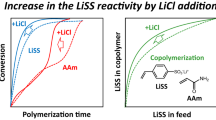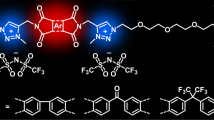Abstract
The synthesis of bidirectional anionic initiators by the reaction between metallic lithium (Li) and naphthalene (Naph), under mild conditions, in non-polar (benzene) or low-polarity media (benzene/THF mixtures) is reported. The efficiency of these initiators to provide macromolecules with well-defined structures was demonstrated. Model linear homopolymers from styrene (S) or hexamethyl(ciclotrisiloxane) (D3) monomers were synthesized using classical anionic polymerization (high-vacuum techniques). The model polymers obtained were analyzed using the conventional analytical techniques, and showed narrow molar mass distributions, a broad range of molar masses (from 3000 to 1,000,000 g/mol) and polydispersity indexes (M w/M n) lower than 1.1. High molar mass polymers were obtained using pure benzene as solvent, whereas lower molar masses were obtained in benzene/THF mixtures in which the concentration of THF was lower than 10 % v/v. The ratio [Li]/[Naph] and the nature of the reaction medium are the experimental parameters to be controlled to obtain the desired lithium naphthalenides.








Similar content being viewed by others
References
Duncan R (2003) Nat Rev Drug Discovery 2:349–360
Greer SC (1998) Physical chemistry of equilibrium polymerization. J Phys Chem B 102:5413–5422
Farkas E, Meszena ZG, Johnson AF (2004) Molecular weight distribution design with living polymerization reactions. Ind Eng Chem Res 43:7356–7360
Szwarc M, Van Beylen M, Van Hoyweghen D (1987) Simultaneity of initiation and propagation in living polymer systems. Macromolecules 20:445–448
Matyjaszewsky K (2005) Macromolecular engineering: from rational design through precise macromolecular synthesis and processing to targeted macroscopic material properties. Prog Polym Sci 30:858–875
Ciolino AE, Satti AJ, Villar MA (2011) Initiators for anionic polymerization: old and news developments. In: Ackrine W (ed) Polymer initiators, Chapter 1, 1st edn. Nova Science Publishers, Hauppauge, pp 1–58 (and references therein cited)
Szwarc M, Levy M, Milkovich R (1956) polymerization initiated by electron transfer to monomer. a new method of formation of block polymers. J Am Chem Soc 78:2656–2657
Szwarc M (1956) Living polymers. Nature 178:1168–1169
Baskaran D, Müller AHE (2007) Anionic vinyl polymerization—50 years after Michael Szwarc. Prog Polym Sci 32:173–219
Fetters L, Morton M (1969) Synthesis and properties of block polymers. I. Poly-α-methylstyrene-polyisoprene-poly-α-methylstyrene. Macromolecules 2:453–458
Fetters L (1966) J Res Natl Bureau Stand A Phys Chem 70A:421
Morton M, Kammereck R, Fetters L (1971) Synthesis and properties of block polymers. II. Poly(α-methylstyrene)-poly(propylene sulfide)-poly(α-methylstyrene). Macromolecules 4:11–15
Worsfold D, Bywater S (1960) Anionic polymerization of styrene: conductivity measurements. J Chem Soc, pp 5234–5238
Worsfold D, Bywater S (1957) Anionic polymerization of α-methylstyrene. J Polym Sci 26:299–304
Roovers J, Toporowski P (1983) Synthesis of high molecular weight ring polystyrenes. Macromolecules 16:843–849
Hsieh H, Quirk R (1996). Anionic polymerization: principles and practical applications, Chapter 5. Marcel Dekker, New York, pp 93–110
Hsieh H, Quirk R (1996). Anionic polymerization: principles and practical applications, Chapter 11. Marcel Dekker, New York, pp 261–306
Hadjichristidis N, Iatrou H, Pitsikalis M, Pispas S (2000) Anionic polymerization: high vacuum techniques. J Polym Sci Part A Polym Chem 38:3211–3234
Uhrig D, Mays J (2005) Experimental techniques in high-vacuum anionic polymerization. J Polym Sci Part A Polym Chem 43:6179–6222
Seyferth D (2009) The grignard reagents. Organometallics 28:1598–1605
Ishizu K, Kanno H (1996) Novel synthesis and characterization of cyclic polystyrenes. Polymer 37:1487–1492
Kim J, Lee M, Ryu C, Lee J, Hwang S, Park T, Kim K, Yoon H, Ahn B, Char K, Ryu J, Quirk R (1994) Synthesis of dilithium α, ω-disulfonated polystyrene by anionic polymerization. Polym J 26:1111–1117
Dong D, Hogen-Esch TE (2001) Synthesis and characterization of macrocyclic poly(α-methylstyrene). e-Polymers 7:54–65
Hsieh H, Kao H, Cheng O, Tsiang R, Huang D (1995) Polymerization of styrene-butadiene block copolymers using a dicarbanion initiator made by the reaction of lithium with. alpha.-methylstyrene. Macromolecules 28:4383–4390
Rummel S, Ilatovskaya MA, Yunusov SM, Kalyuzhnaya ES, Shur VB (2009) Activation of C-H bonds of hydrocarbons by the ArH–alkali metal systems in THF (ArH–naphthalene, biphenyl, anthracene, phenanthrene, trans-stilbene, pyrene). Alkylation of naphthalene and toluene with ethene. J Organomet Chem 694:1459–1466
Fetters L, Kamienski C, Morrison R, Young R (1979) Remarks on organodilithium initiators. Macromolecules 12:344–346
Melero C, Guijarro A, Yus M (2009) Structural characterization and bonding properties of lithium naphthalene radical anion, [Li+(TMEDA)2][C10H8·−], and lithium naphthalene dianion [(Li+TMEDA)2C10H −28 ]. Dalton Trans 8:1286–1289. doi:10.1039/B821119C
Yus M, Herrera R, Guijarro A (2002) On the mechanism of arene-catalyzed lithiation: the role of arene dianions—naphthalene radical anion versus naphthalene dianion. Chem Eur J 8:2574–2584
Kurata M, Tsunashima Y (1999) Section VII: solution properties. In: Immergut EH, Grulke EA (eds) Polymer handbook, 4th edn. Wiley, New York
Seyferth D (2006) Alkyl and aryl derivatives of the alkali metals: useful synthetic reagents as strong bases and potent nucleophiles. 1. Conversion of organic halides to organoalkali-metal compounds. Organometallics 25:2–24
Matmour R, Lebreton A, Tsitsilianis C, Kallitsis I, Héroguez V, Gnanou Y (2005) Tri- and tetracarbanionic initiators by a lithium/halide exchange reaction: application to star-polymer synthesis. Ang Chem Int Ed 44(2):284–287
Rogers M (1946) The electric moment of n-butyllithium and the nature of the lithium-carbon bond. J Am Chem Soc 68:2748
Carnahan J, Closson W (1972) Reaction of naphthalene dianions with tetrahydrofuran and ethylene. J Org Chem 37:4469–4471
Scott N, Walker J, Hansley V (1936) Sodium naphthalene. I. A new method for the preparation of addition compounds of alkali metals and polycyclic aromatic hydrocarbons. J Am Chem Soc 58:2442–2444
Brooks J, Rhine W, Stucky G (1972) pi.-Groups in ion pair bonding. Stabilization of the dianion of naphthalene by lithium tetramethylethylenediamine. J Am Chem Soc 94:7346–7351
Cserhegyi A, Chaudhuri J, Franta E, Jagur-Grodzinski J, Szwarc M (1967) Radical-anion reactions in hexamethylphosphorotriamide. J Am Chem Soc 89:7129–7130
Anslyn EV, Dougherty DA (2006) Modern physical organic chemistry. University Science Book, California
Holy N (1974) Reactions of the radical anions and dianions of aromatic hydrocarbons. Chem Rev 74:243–277
Hirota N (1968) Electron paramagnetic resonance studies of ion pairs. Structures and equilibria in alkali metal naphthalenide and anthracenide. J Am Chem Soc 90:3603–3611
Smid J, Hogen-Esch T (1965) Solvent-Separated Ion Pairs of Carbanions. J Am Chem Soc 87:669–670
Smid J (1965) A stable dianion of naphthalene. J Am Chem Soc 87:655
Rathman T, Bailey W (2009) Optimization of organolithium reactions. Org Process Res Dev 13:144–151
Bauer W, Winchester W, von Ragu Schleyer P (1987) Monomeric organolithium compounds in tetrahydrofuran: tert-butyllithium, sec-butyllithium, supermesityllithium, mesityllithium, and phenyllithium. Carbon-lithium coupling constants and the nature of carbon-lithium bonding. Organometallics 6:2371–2379
Smid J, Hogen-Esch J (1966) Studies of contact and solvent-separated ion pairs of carbanions. I. Effect of temperature, counterion, and solvent. J Am Chem Soc 88:307–318
Garst J, Cole R (1962) Solvent effect on the disproportionation of monosodium tetraphenylethylene. J Am Chem Soc 84:4352–4353
Garst J, Zabolotny E, Cole R (1964) Disproportionation of monosodium tetraphenylethylene. J Am Chem Soc 86:2257–2261
Garst J, Zabolotny E (1965) Electron transfer equilibria. IV. Effects of metal ion and temperature on the disproportionation of monoalkali tetraphenylethylenes. J Am Chem Soc 87:495–501
Slates RV, Szwarc M (1965) Dissociative equilibria in the systems aromatic hydrocarbon[UNK], Na+ ⇄ Radical Anion[UNK] + Na+. J Phys Chem 69:4124–4131
Pola J, Levin G, Szwarc M (1976) Equilibrium and kinetic studies of disproportionation of sodium tetracenide in benzene. The effect of added tetrahydrofuran. J Phys Chem 80:1690–1692
Garst JF, Roberts RD, Abels BN (1975) Solvent effects on reactions of sodium naphthalene with hexyl fluoride. J Am Chem Soc 97:4925–4929
Garst J, Klein R, Walmsley D, Zabolotny E (1965) Ion aggregate spectra and solvent polarity. J Am Chem Soc 87:4080–4084
Pacifici JD, Garst JF, Janzen EG (1965) An unusual solvent effect on the air oxidation of a stable carbanion. J Am Chem Soc 87:3014–3015
Szwarc M (1972) Radical anions and carbanions as donors in electron-transfer processes. Acc Chem Res 5:169–176
Lundgren B, Levin G, Claesson S, Szwarc M (1975) Disproportionation of the lithium salt of tetraphenylethylene radical anions in THF. Equilibrium and kinetic study. J Am Chem Soc 97:262–267
Levin G, Jagur-Grodzinski J, Szwarc M (1970) Chemistry of radical anions and dianions of diphenylacetylene. J Am Chem Soc 92:2268–2275
Tobolsky A, Hartley D (1962) Initiation of methyl methacrylate by aromatic radical-anions. J Am Chem Soc 84:1391–1393
Morton M, Rembaum A, Bostick E (1958) Polymerization of cyclic oxides initiated by electron transfer. J Polym Sci 32:530–532
Bellas V, Iatrou H, Hadjichristidis N (2000) Controlled anionic polymerization of hexamethylcyclotrisiloxane. Model linear and miktoarm star co- and terpolymers of dimethylsiloxane with styrene and isoprene. Macromolecules 33:6993–6997
Ninago MD, Satti AJ, Ressia JA, Ciolino AE, Villar MA, Vallés EM (2009) Controlled synthesis of poly(dimethylsiloxane) homopolymers using high-vaccum anionic polymerization techniques. J Polym Sci A Polym Chem 47:4774–4783
Hsieh H, Quirk R (1996). Anionic polymerization: principles and practical applications, Chapter 24. Marcel Dekker, New York, pp 685–710
Hummel DO, Scholl F (1988) Atlas of polymer and plastic analysis, vol 2, Chapter 5. Carl Hanser Verlag, Munich, pp 284–306
Acknowledgments
We express our gratitude to the Consejo Nacional de Investigaciones Científicas y Técnicas de la República Argentina (CONICET), the Agencia Nacional de Promoción Científica y Tecnológica (ANPCyT), and the Universidad Nacional del Sur (UNS, Argentina) for their financial support. The authors also wish to thank Dr. Cristian Vitale for the 1H-NMR spectrum and his helpful advices in the analysis.
Author information
Authors and Affiliations
Corresponding author
Rights and permissions
About this article
Cite this article
Ninago, M.D., Marani, M.L.S., González, V.A. et al. Lithium naphthalenides in non-polar or in low-polarity media: some insights regarding their use as initiators in anionic polymerizations. Polym. Bull. 74, 307–323 (2017). https://doi.org/10.1007/s00289-016-1715-2
Received:
Revised:
Accepted:
Published:
Issue Date:
DOI: https://doi.org/10.1007/s00289-016-1715-2




